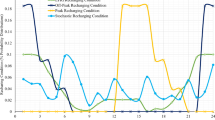Abstract
This paper presents a calibration method of a rule-based energy management strategy designed for a plug-in hybrid electric vehicle, which aims to find the optimal set of control parameters to compromise within the conflicting calibration requirements (e.g. emissions and economy). A comprehensive evaluating indicator covering emissions and economy performance is constructed by the method of radar chart. Moreover, a radial basis functions (RBFs) neural network model is proposed to establish a precise model within the control parameters and the comprehensive evaluation indicator. The best set of control parameters under offline calibration is gained by the multi-island genetic algorithm. Finally, the offline calibration results are compared with the experimental results using a chassis dynamometer. The comparison results validate the effectiveness of the proposed offline calibrating approach, which is based on the radar chart method and the RBF neural network model on vehicle performance improvement and calibrating efficiency.
Similar content being viewed by others
Abbreviations
- b e :
-
brake specific fuel consumption of engine, g/kWh
- k hi :
-
coefficient of upper limit of engine optimal torque, %
- k low :
-
coefficient of lower limit of engine optimal torque, %
- SOC tar :
-
target value of SOC, %
- SOC max :
-
allowable upper limit of SOC tar range, %
- SOC min :
-
allowable lower limit of SOC tar range, %
- T e :
-
engine torque, Nm
- T m :
-
electric motor torque, Nm
- T req :
-
torque requirement of tire, Nm
- T lo_optT :
-
torque of engine optimal lower limit, Nm
- T hi_optT :
-
torque of engine optimal upper limit, Nm
- v r :
-
velocity of entering the regenerative braking mode, km/h
- v 0 :
-
velocity of activating engine, km/h
- w e :
-
engine speed, rpm
- w m :
-
electric motor speed, rpm
- η 0 :
-
transmission efficiency of i 0, %
- η m :
-
transmission efficiency of i m, %
- η e :
-
transmission efficiency of i e, %
- η 0 :
-
transmission efficiency of i 0, %
- ΔSOC :
-
SOC gap between SOC tar and SOC max (SOC min), %
References
Albo, Y., Lanir, J., Bak, P. and Rafaeli, S. (2016). Off the radar: Comparative evaluation of radial visualization solutions for composite indicators. IEEE Trans. Visualization And Computer Graphics 22, 1, 569–578.
Arnaiz-Gonzalez, A., Fernandez-Valdivielso, A., Bustillo, A. and de Lacalle, L. N. L. (2016). Using artificial neural networks for the prediction of dimensional error on inclined surfaces manufactured by ball-end milling. Int. J. Advanced Manufacturing Technology 83, 5, 847–859.
Amozegar, M. and Khorasani, K. (2016). An ensemble of dynamic neural network identifiers for fault detection and isolation of gas turbine engines. Neural Networks, 76, 106–121.
Anbaran, S. A., Idris, N. R. N., Jannati, M., Aziz, M. J. and Alsofyani, I. (2014). Rule-based supervisory control of split-parallel hybrid electric vehicle. IEEE Conf. Energy Conversion, 7–12.
Bang, J. S. and Kim, T. S. (2015). Automatic calibration of a resolver offset of permanent magnet synchronous motors for hybrid electric vehicles. Proc. American Control Conf., 4174–4179.
Fekri, S. and Assadian, F. (2012). The design and development of multivariable controls with the application for energy management of hybrid electric vehicles. Int. J. Vehicle Design 60, 3–4, 308–317.
Geng, B., Mills, J. K. and Sun, D. (2014). Combined power management/design optimization for a fuel cell/battery plug-in hybrid electric vehicle using multi-objective particle swarm optimization. Int. J. Automotive Technology 15, 4, 645–654.
Geng, B., Mills, J. K. and Sun, D. (2011). Energy management control of microturbine powered plug-in hybrid electric vehicles using the telemetry equivalent consumption minimization strategy. IEEE Trans. Vehicular Technology 60, 9, 4238–4248.
HomChaudhuri, B., Lin, R. N. and Pisu, P. (2016). Hierarchical control strategies for energy management of connected hybrid electric vehicles in urban roads. Transportation Research Part C: Emerging Technologie, 62, 70–86.
Hu, F. and Zhao, Z. G. (2010). Development of hybrid electric vehicle control system based on v-cycle. Int. Conf. Applied Mechanics and Mechanical Engineering, 29-32, 918–922.
Keyvanshokooh, E., Ryan, S. and Kabir, E. (2016). Hybrid robust and stochastic optimization for closed-loop supply chain network design using accelerated Benders decomposition. Euro. J. Operational Research 249, 1, 76–92.
Lee, D. H., Kim, N. W., Jeong, J. R., Park, Y. I. and Cha, S. W. (2013). Component sizing and engine optimal operation line analysis for a plug-in hybrid electric transit bus. Int. J. Automotive Technology 14, 3, 459–469.
Long, V. T. and Nhan, N. V. (2012). Bees-algorithm-based optimization of component size and control strategy parameters for parallel hybrid electric vehicles. Int. J. Automotive Technology 13, 7, 1177–1183.
Ma, C., Ko, S. Y., Jeong, K. Y. and Kim, H. S. (2013). Design methodology of component design environment for PHEV. Int. J. Automotive Technology 14, 5, 785–795.
Ma, C., Kang, J., Choi, W., Song, M., Ji, J. and Kim, H. (2012). A comparative study on the power characteristics and control strategies for plug-in hybrid electric vehicles. Int. J. Automotive Technology 13, 3, 505–516.
Murgovski, N., Grahn, M., Johannesson, L. M. and McKelvey, T. (2015). Automated engine calibration of hybrid electric vehicles. IEEE Trans. Control Systems Technology 23, 3, 1063–1074.
Sorrentino, M., Pianese, C. and Maiorino, M. (2013). An integrated mathematical tool aimed at developing highly performing and cost-effective fuel cell hybrid vehicles. J. Power Sources, 221, 308–317.
Wang, D. F., Jiang, R. C., Wan, N., Cheng, C. and Jin, L. G. (2016). Multi-objective optimization for lightweight design of twist beam suspension. Int. Conf. Design, Manufacturing and Mechatronics, 1228–1237.
Wang, J., Wang, Q. N., Wang, P. Y., Wang, J. N. and Zou, N. W. (2015). Hybrid electric vehicle modeling accuracy verification and global optimal control algorithm research. Int. J. Automotive Technology 16, 3, 513–524.
Wang, J. X., Shen, W. H., Wang, Z. D., Yao, M. Y. and Zeng, X. H. (2014). Multi-objective optimization of drive gears for power split device using surrogate models. J. Mechanical Science and Technology 28, 6, 2205–2214.
Xu, L., Ouyang, M., Li, J., Yang, F., Lu, L. and Hua, J. (2013). Optimal sizing of plug-in fuel cell electric vehicles using models of vehicle performance and system cost. Applied Energy, 103, 477–487.
Zeng, X. R. and Wang, J. M. (2015). A parallel hybrid electric vehicle energy management strategy using stochastic model predictive control with road grade preview. IEEE Trans. Control Systems Technology 23, 6, 2416–2423.
Zhou, J. H. and Yuan, Y. N. (2015). Calibration experiments on engine emission behaviour during the stopping-andrestarting process in a hybrid electric vehicle application. Proc. Institution of Mechanical Engineers, Part D: J. Mechanical Engineering 225, D4, 499–511.
Author information
Authors and Affiliations
Corresponding author
Rights and permissions
About this article
Cite this article
Duan, B.M., Wang, Q.N., Wang, J.N. et al. Calibration efficiency improvement of rule-based energy management system for a plug-in hybrid electric vehicle. Int.J Automot. Technol. 18, 335–344 (2017). https://doi.org/10.1007/s12239-017-0034-4
Received:
Revised:
Accepted:
Published:
Issue Date:
DOI: https://doi.org/10.1007/s12239-017-0034-4




